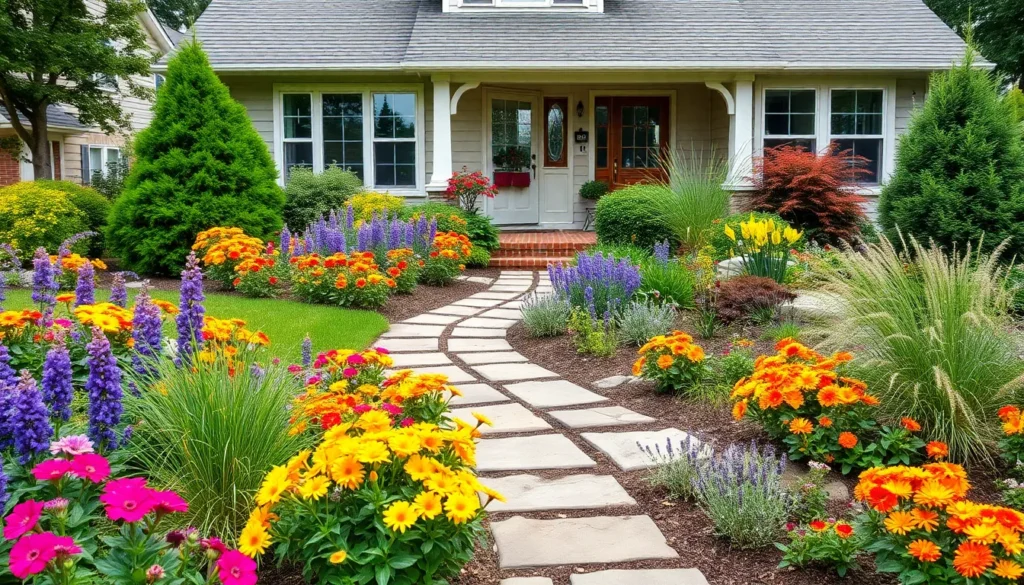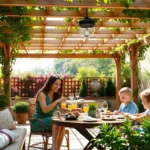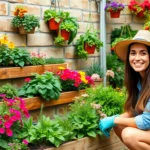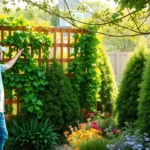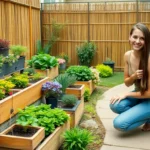Your front yard sets the stage for your entire home – it’s the first impression visitors get and the view you see every time you come home. We understand that creating a stunning front yard garden can feel overwhelming with so many design possibilities and plant choices available.
Whether you’re working with a sprawling lawn or a compact urban space we’ve gathered the most effective front yard garden ideas that’ll transform your outdoor area into a welcoming masterpiece. From low-maintenance succulent displays to colorful seasonal flower beds these creative answers work for every budget and skill level.
We’ll show you proven strategies that boost your home’s curb appeal while creating a garden space that reflects your personal style and fits your lifestyle perfectly.
Create a Welcoming Entrance With Foundation Plantings
Foundation plantings form the cornerstone of any successful front yard garden design. These strategic plant arrangements bridge the gap between your home’s architecture and the surrounding industry.
Choose Low-Maintenance Evergreen Shrubs
Evergreen shrubs provide year-round structure and color to your front yard garden entrance. We recommend selecting varieties like boxwood, yew, or holly that maintain their shape with minimal pruning. These plants offer consistent visual appeal through all seasons while requiring less water and care than deciduous alternatives.
Boxwood shrubs work exceptionally well for formal garden designs because they respond beautifully to shaping and trimming. Yew varieties provide dense, dark green foliage that creates an elegant backdrop for seasonal plantings. Holly bushes add texture with their glossy leaves and often produce colorful berries that attract wildlife.
Consider the mature size of each shrub when planning your foundation planting layout. Plant smaller varieties like dwarf boxwood closer to walkways and larger specimens such as skip laurel against taller walls. This layered approach creates visual depth while ensuring plants don’t overwhelm your home’s entrance over time.
Add Seasonal Color With Flowering Perennials
Flowering perennials bring vibrant seasonal interest to foundation plantings without the annual replanting costs. We suggest incorporating varieties that bloom at different times throughout the growing season to maintain continuous color. Hostas provide lush foliage and elegant white or purple flower spikes in summer shade areas.
Daylilies offer abundant blooms in colors ranging from soft yellow to deep burgundy and thrive in both sun and partial shade conditions. Astilbe produces feathery plumes in pink, white, or red that brighten shadier spots near your home’s foundation. These perennials return each year stronger and more established than the previous season.
Plant perennials in groups of three or five for maximum visual impact rather than spacing them individually throughout the bed. This clustering technique creates bold color masses that draw the eye and make a stronger design statement than scattered individual plants.
Incorporate Ornamental Grasses for Texture
Ornamental grasses add movement, texture, and architectural interest to foundation plantings year round. We recommend fountain grass, feather reed grass, or blue fescue to create ever-changing contrast against the solid forms of evergreen shrubs. These grasses sway gracefully in breezes and provide winter interest with their dried seed heads.
Fountain grass produces soft, bottlebrush-like plumes that catch sunlight and create beautiful silhouettes against your home’s exterior walls. Feather reed grass grows upright in neat clumps and maintains its structure through winter months. Blue fescue offers fine-textured, steel blue foliage that complements both warm and cool-toned home exteriors.
Position taller grasses like miscanthus toward the back of foundation beds where they won’t obstruct windows or pathways. Place shorter varieties such as mondo grass or liriope along borders where their neat growth habit defines planting bed edges without requiring frequent maintenance.
Design Curved Garden Beds for Visual Appeal
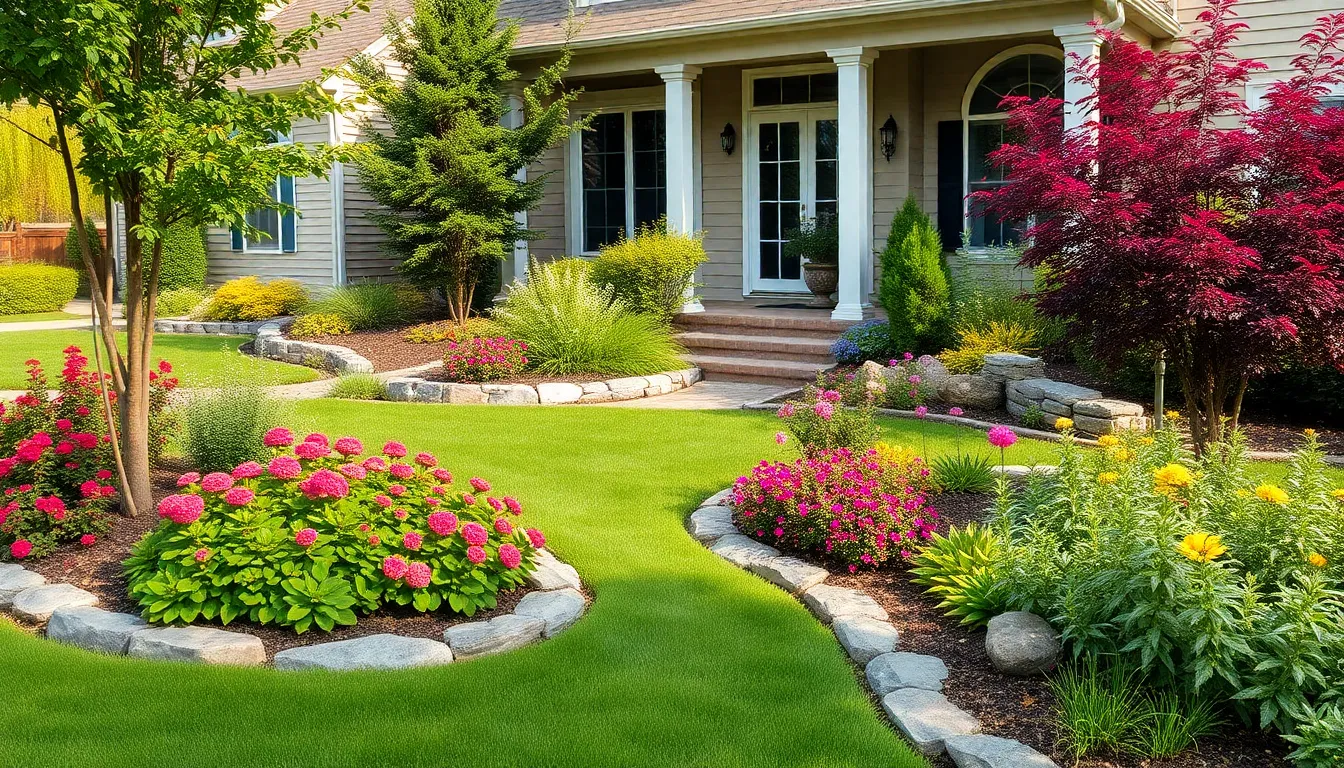
Curved garden beds naturally complement your home’s architecture while creating a softer transition from your foundation plantings to the broader industry. These organic shapes flow more harmoniously with nature than rigid straight lines.
Use Natural Stone or Brick Edging
Natural stone edging defines your curved beds while preventing mulch and soil from migrating into surrounding lawn areas. We recommend using fieldstone, limestone, or sandstone for a timeless appearance that complements most architectural styles. Brick edging offers another durable option that adds warmth and texture to garden borders.
Installing edging materials at ground level creates clean lines while allowing your mower to pass over them easily. Stack stones two to three layers high for dramatic definition in larger spaces. Choose materials that echo your home’s exterior elements like matching brick or complementary stone colors.
Plant in Layers From Tall to Short
Layered plantings maximize visual impact by creating depth and dimension within your curved beds. Position tall specimen trees or large shrubs toward the back of beds, followed by medium height perennials in the middle zone. Ground covers and low growing plants fill the front edge for a cascading effect.
This tiered approach ensures every plant receives adequate sunlight while preventing taller specimens from overshadowing shorter companions. We suggest maintaining 18 to 24 inches between plant groupings to allow for mature growth. Plan your layers to include plants with varying bloom times for extended seasonal interest.
Create Focal Points With Specimen Plants
Specimen plants serve as anchor points that draw the eye through your curved garden design. Select plants with distinctive characteristics like vibrant foliage, unique bark texture, or exceptional flowering displays. Japanese maples, flowering dogwoods, and ornamental pears make excellent focal specimens for most front yard settings.
Position these standout plants at natural viewing points along your curved beds rather than centering them geometrically. We recommend limiting focal specimens to one or two per bed to avoid visual competition. Choose plants that offer multiple seasons of interest through spring blooms, summer foliage, fall color, or winter structure.
Install a Front Yard Vegetable Garden
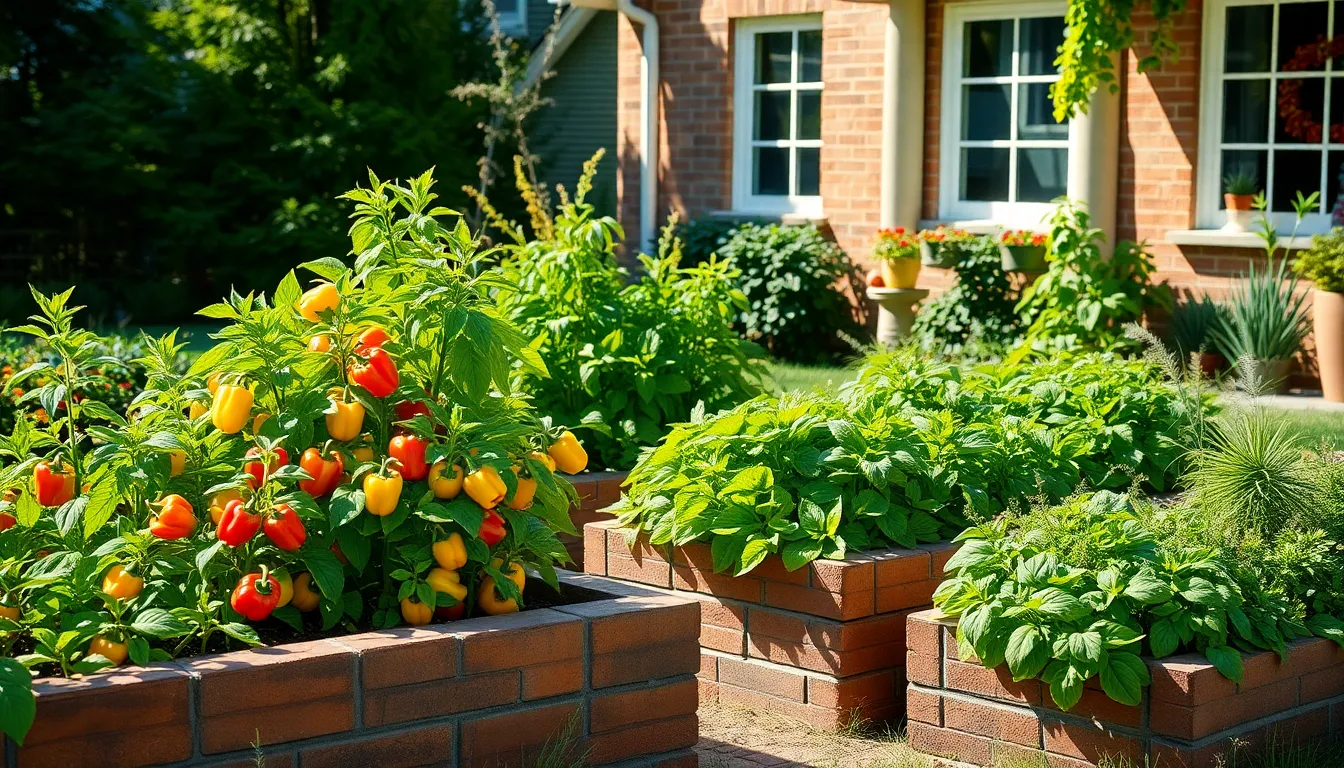
Creating a front yard vegetable garden transforms your industry into a productive and visually stunning space. This approach combines functionality with curb appeal while providing fresh produce steps from your door.
Select Attractive Edible Plants
Choosing vegetables that offer both beauty and nutrition creates the perfect balance for front yard gardens. Colorful bell peppers in shades of red, yellow, and orange provide vibrant focal points while delivering fresh produce throughout the growing season. Leafy greens like Swiss chard with its colorful stems or purple kale add striking textures and colors to your industry design.
We recommend incorporating edible plants that thrive in containers or hanging baskets for added flexibility and vertical interest. Cherry tomatoes cascading from hanging planters create beautiful living curtains while producing abundant fruit. Combining these productive plants with complementary flowers and shrubs ensures your front yard maintains its aesthetic appeal year round.
Build Raised Beds for Better Organization
Raised beds provide structure and intentional design elements that elevate your front yard’s appearance from amateur to professional. These elevated planting areas offer better drainage control and soil management while creating clear boundaries between different garden zones. Materials like clay bricks or upcycled wooden pallets deliver both durability and visual appeal at various price points.
Installing a drip irrigation system within your raised beds ensures efficient water distribution while maintaining the clean appearance of your front yard design. Square foot gardening techniques work exceptionally well in raised bed systems, allowing you to maximize space utilization while creating visually appealing geometric patterns. This organized approach makes maintenance easier and keeps your front yard looking tidy and well planned.
Include Herbs Near the Kitchen Window
Positioning herbs close to your kitchen window provides convenient access for cooking while adding pleasant aromas to your front entrance area. Popular choices like basil, rosemary, and thyme offer both culinary functionality and attractive foliage that complements other industry elements. These aromatic plants release their fragrances when brushed against, creating a sensory experience for visitors approaching your home.
We suggest grouping herbs in attractive containers or dedicated bed sections that receive adequate sunlight throughout the day. Mediterranean herbs like oregano and sage thrive in well drained conditions and provide year round structure with their silvery foliage. This strategic placement ensures you’ll actually use these herbs regularly while they contribute to your front yard’s overall design scheme.
Add Vertical Interest With Trees and Tall Plants

Incorporating trees and tall plants transforms flat front yard spaces into ever-changing landscapes with multiple visual layers. We can create stunning vertical elements that draw the eye upward while establishing the framework for our entire garden design.
Plant Shade Trees for Long-Term Value
Oak and maple trees offer exceptional long-term investment returns for our front yard gardens. These shade providers mature into magnificent specimens that dramatically increase property value while reducing cooling costs during summer months. We should consider their mature size carefully when selecting planting locations, as these trees can reach substantial heights of 60-80 feet and spread 40-60 feet wide.
Planning for future growth prevents costly relocation issues and ensures adequate space for both the tree and surrounding plantings. We gain multiple benefits from shade trees including improved air quality, wildlife habitat creation, and dramatic seasonal color changes that enhance curb appeal year-round.
Use Columnar Trees in Narrow Spaces
Columnar apple trees and ‘Sky Pencil’ holly varieties excel in tight spaces where traditional trees won’t fit. We can achieve impressive vertical impact without sacrificing precious square footage in compact front yards or narrow side areas. These upright growers typically reach 10-15 feet in height while maintaining a slender 3-4 foot width throughout their lifespan.
Positioning columnar specimens near entryways or property lines creates striking architectural elements that complement our home’s design. We should space these narrow trees 6-8 feet apart for optimal growth and visual balance while ensuring they receive adequate sunlight for healthy development.
Create Privacy With Evergreen Screens
Cedar and arborvitae provide year-round privacy screening that maintains its effectiveness through all seasons. We can establish living barriers that block unwanted views while creating attractive backdrops for our front yard plantings. These evergreen options grow 6-12 inches annually, allowing us to achieve desired privacy levels within 3-5 years of installation.
Strategic placement along property boundaries or near windows maximizes privacy benefits while maintaining neighborly relationships. We should plant evergreen screens in straight or curved lines, spacing them according to their mature width to ensure complete coverage without overcrowding as they develop.
Incorporate Hardscape Elements for Structure
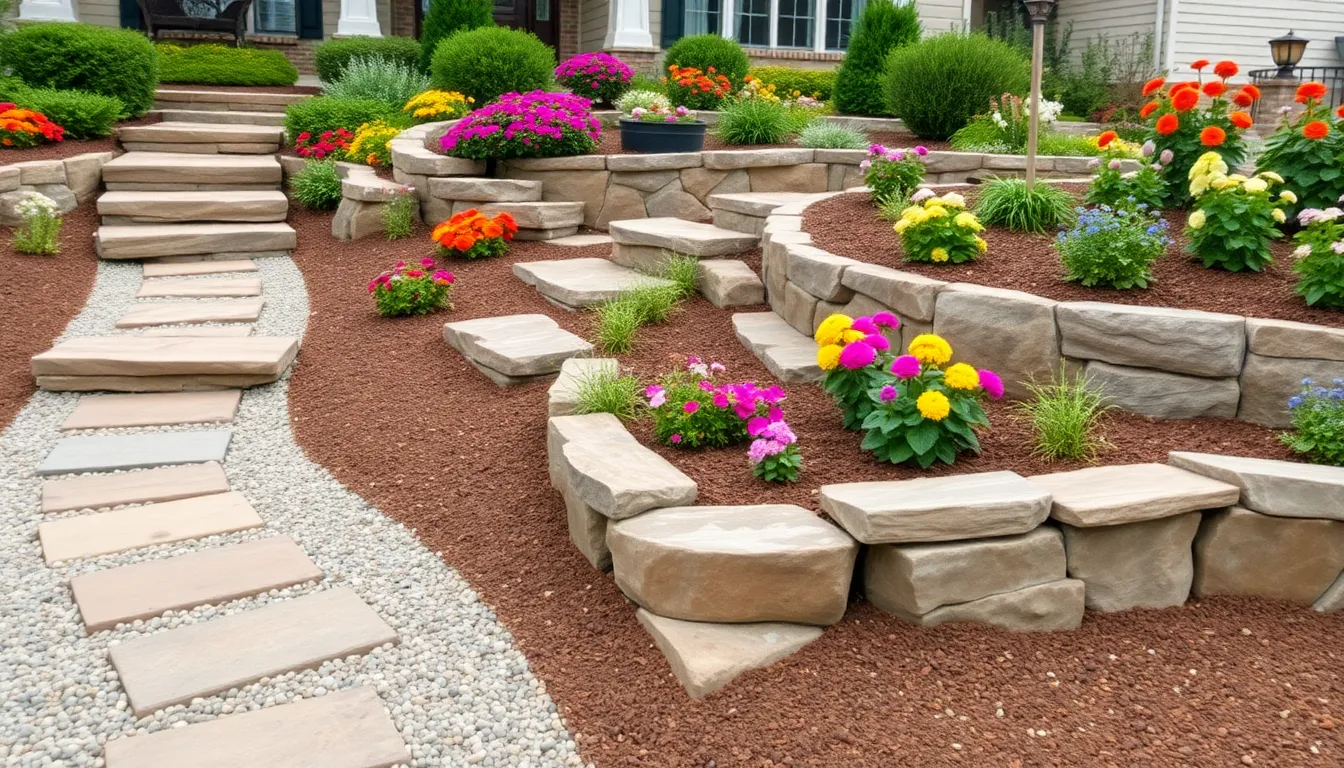
Adding hardscape elements creates lasting structure that complements your plantings throughout the seasons. These permanent features establish the backbone of your front yard design while requiring minimal maintenance once installed.
Build Pathways With Natural Materials
Stone pavers offer exceptional durability and create a textured, sophisticated look that withstands heavy foot traffic. We recommend using granite or bluestone for classic appeal that complements various architectural styles. Natural stone develops character over time as it weathers and settles into the industry.
Gravel pathways provide an affordable option that’s easy to install and maintain while creating a pleasant crunching sound underfoot. Decomposed granite works particularly well for a refined rustic appearance that compacts naturally over time. These materials drain well and prevent muddy walkways during rainy seasons.
Wooden planks add warmth and natural appeal to front yard pathways, especially when using weather-resistant cedar or teak. Spacing planks slightly apart allows for drainage and creates visual interest through shadow patterns. Wood pathways work exceptionally well in cottage garden settings and modern industry designs.
Add Decorative Garden Borders
Edging stones create clean, defined lines that separate garden beds from lawn areas while preventing grass encroachment. Small river rocks or fieldstone provide a natural appearance that complements both formal and informal garden styles. These borders also help retain mulch and prevent soil erosion during heavy rains.
Brick edging offers a more structured, formal appearance that works beautifully with traditional home architecture. Concrete edging provides similar benefits with greater customization options for curves and intricate shapes. Both materials create permanent answers that maintain their appearance for decades with minimal upkeep.
Living borders using moss or creeping thyme add a soft, lush element that changes with the seasons. These plant borders require more maintenance but provide fragrance and seasonal blooms that enhance the overall garden experience. Low growing perennials create gentle transitions between different garden zones.
Install Low Retaining Walls for Slopes
Stone retaining walls provide essential slope stability while adding important architectural interest to front yard gardens. Natural fieldstone or cut stone blocks create durable structures that can last for generations with proper installation. These walls also create opportunities for tiered planting areas that maximize growing space on sloped lots.
Tiered planters work effectively for moderate slopes and offer flexibility in plant selection and garden design. Built-in seating can be incorporated into taller retaining structures to create functional outdoor living spaces. These features help prevent soil erosion while creating distinct garden zones for different plant collections.
Gabion walls use wire cages filled with rocks or stones to create natural looking barriers that blend seamlessly with industry surroundings. These structures allow for drainage while providing excellent stability for steep grades. Gabion walls cost less than traditional stone masonry while offering similar aesthetic appeal and functionality.
Plant a Pollinator-Friendly Front Garden
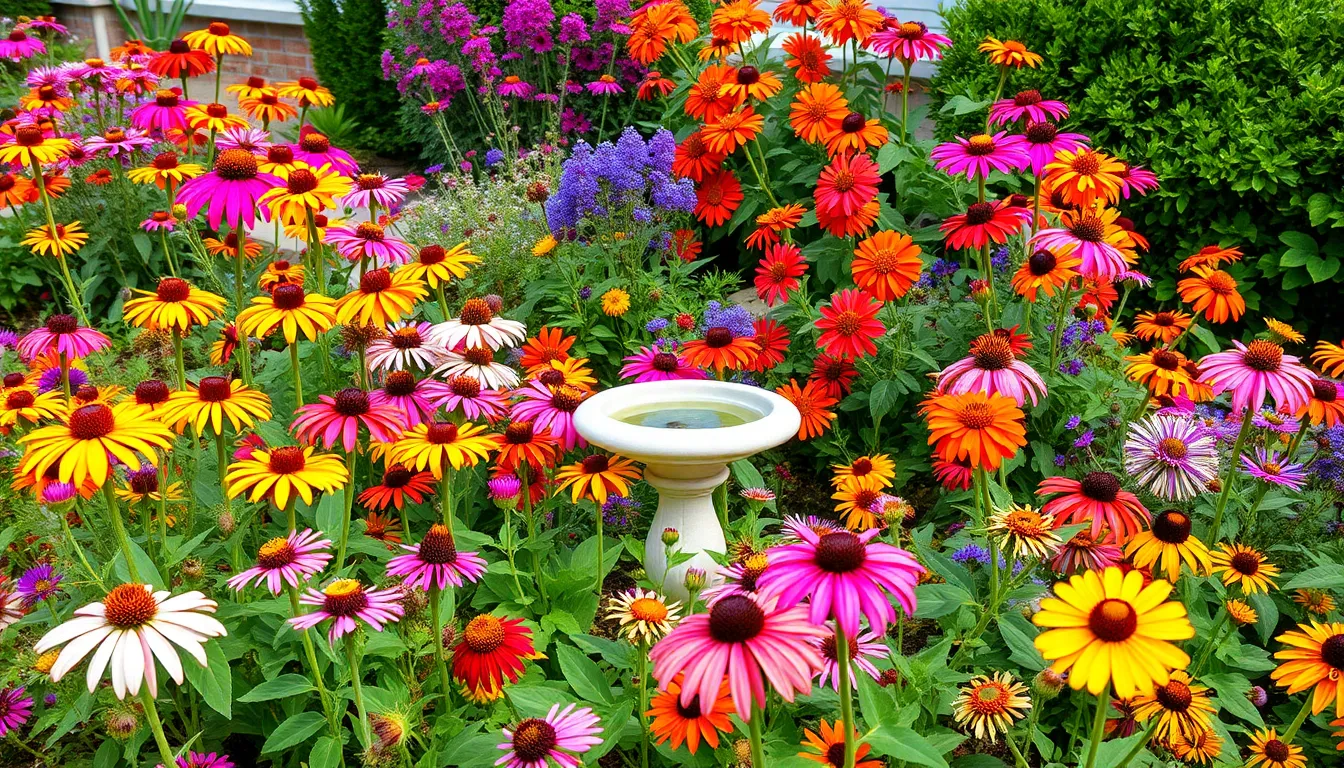
Supporting local wildlife while creating stunning curb appeal becomes effortless when we design our front gardens with pollinators in mind. This approach transforms our yards into vibrant ecosystems that benefit both our homes and the environment.
Choose Native Flowering Plants
Native plants offer the strongest foundation for pollinator success because they’ve evolved alongside local wildlife species. We recommend incorporating coneflowers, black-eyed Susans, and bee balm as these naturally attract regional pollinators while requiring minimal maintenance. Selecting plants already adapted to our climate ensures they’ll thrive without extensive watering or fertilizing.
Vibrant color combinations create visual appeal while serving exact pollinator needs throughout our gardens. Warm tones like red, orange, and yellow attract butterflies and hummingbirds, while cool tones including purple and blue draw bees and other beneficial insects. This strategic color planning maximizes both aesthetic impact and wildlife support.
Include Plants That Bloom Throughout Seasons
Seasonal blooming schedules provide continuous nectar and pollen sources that sustain pollinators year-round. Early spring bloomers like crocus and daffodil offer the first food sources when pollinators emerge from winter dormancy. Summer varieties including zinnias and cosmos maintain peak activity during the busiest pollinator months.
Fall flowering plants such as asters and sedum extend the feeding season into autumn when many pollinators prepare for winter. We create the most effective pollinator gardens by ensuring at least one flowering species blooms during each season. This continuous bloom cycle supports complete pollinator life cycles rather than just brief feeding periods.
Provide Water Sources for Wildlife
Water features become essential gathering spots that attract diverse wildlife beyond just pollinators. Shallow birdbaths and small ponds provide drinking water for bees, butterflies, and beneficial insects while adding visual interest to our front gardens. We change the water regularly to prevent mosquito breeding and maintain clean drinking sources.
Strategic placement of water sources near flowering plants creates convenient rest stops for visiting pollinators. Multiple small water features work better than single large ones because they serve different areas of our gardens simultaneously. Adding stones or small branches to water features gives insects safe landing spots for drinking.
Design a Low-Water Front Yard Garden
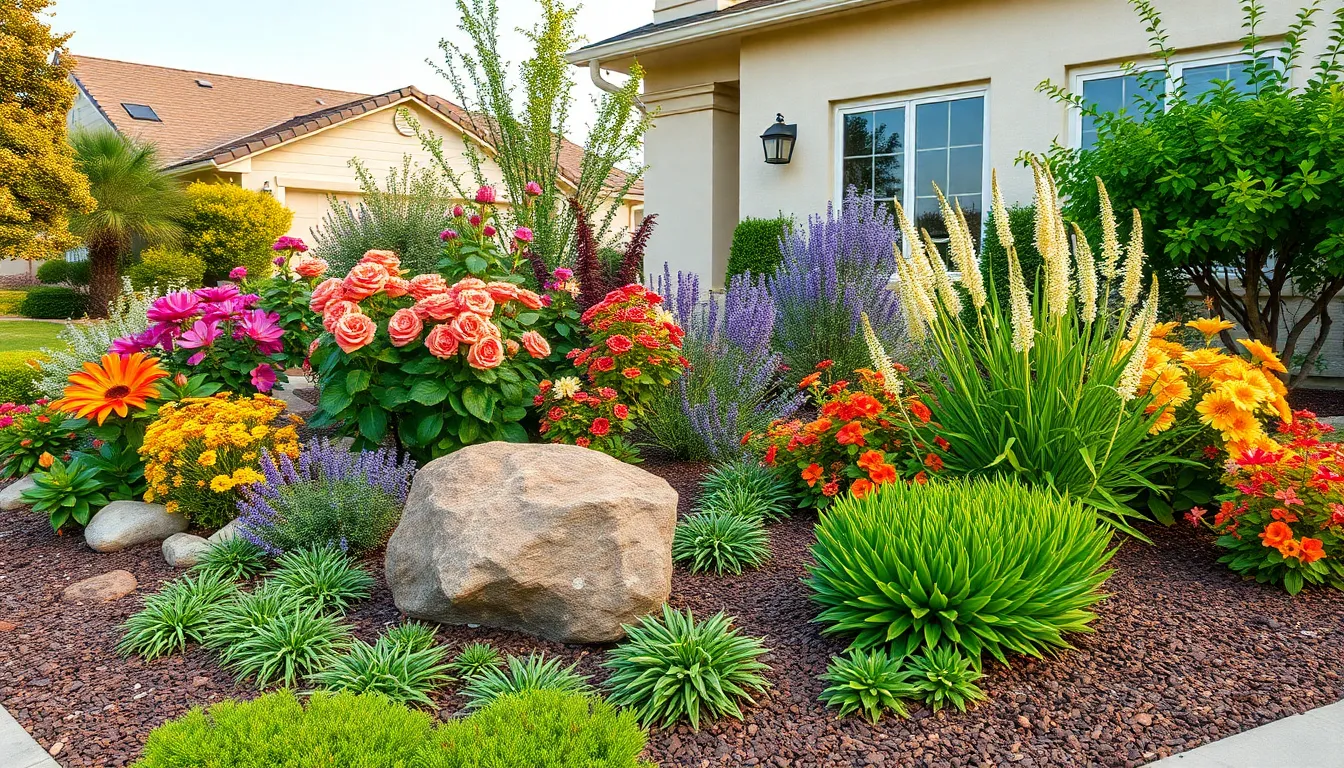
Water conservation doesn’t mean sacrificing beauty in your front yard design. We’ll show you how to create a stunning, sustainable industry that thrives with minimal irrigation.
Select Drought-Tolerant Plant Varieties
Shrub roses offer the perfect starting point for water-wise gardening. We recommend shrub and climbing roses that provide continuous blooms while requiring minimal water once established. These hardy varieties create stunning focal points without demanding daily irrigation.
Groundcover plants transform bare soil into living carpets with minimal maintenance. Ceanothus ‘Carmel Creeper’ spreads beautifully across slopes and flat areas, producing gorgeous blue flowers in spring. Emerald Carpet Manzanita creates dense, evergreen coverage that naturally suppresses weeds while adding year-round structure.
Colorful perennials like pink alstroemeria bring vibrant blooms to drought-tolerant gardens. These hardy plants produce flowers repeatedly throughout the growing season, providing continuous color without excessive water needs. We suggest planting them in clusters for maximum visual impact.
Native plants typically require the least water since they’ve adapted to local climate conditions. Research species native to your region for the most sustainable and low-maintenance options.
Use Mulch to Retain Soil Moisture
Organic mulches create a protective barrier that significantly reduces water evaporation from soil. We recommend applying a 2-3 inch layer of wood chips, bark, or compost around plants to lock in moisture and reduce watering frequency by up to 50%.
Decorative stones serve as attractive, permanent mulch alternatives. Gravel and river rocks reflect heat away from plant roots while preventing soil moisture loss. These materials also create clean, modern aesthetics that complement contemporary home designs.
Mulch placement requires strategic application for maximum effectiveness. Keep mulch 2-3 inches away from plant stems to prevent rot and pest issues. We suggest refreshing organic mulches annually to maintain their moisture-retention properties.
Weed suppression becomes automatic with proper mulching techniques. Dense mulch coverage prevents weed seeds from germinating, eliminating competition for precious water resources.
Group Plants by Water Requirements
Hydrozoning maximizes water efficiency by clustering plants with similar moisture needs. We create separate zones for high, medium, and low-water plants to ensure each receives appropriate irrigation without waste.
High-water zones should occupy the smallest areas and feature the most impactful plants. Position water-loving specimens like certain flowering shrubs near automatic irrigation systems for convenient maintenance.
Medium-water areas work perfectly for seasonal color displays and transitional plantings. These zones bridge the gap between thirsty plants and drought-tolerant varieties, creating natural-looking plant communities.
Dry zones showcase your most water-wise plants in prominent locations. We recommend placing drought-tolerant groundcovers, succulents, and native grasses in these areas to create stunning displays that rarely need supplemental watering.
Irrigation systems become more efficient when designed around plant groupings. Install separate watering zones for each plant group, allowing you to customize watering schedules and amounts based on exact plant needs.
Create Seasonal Interest Year-Round
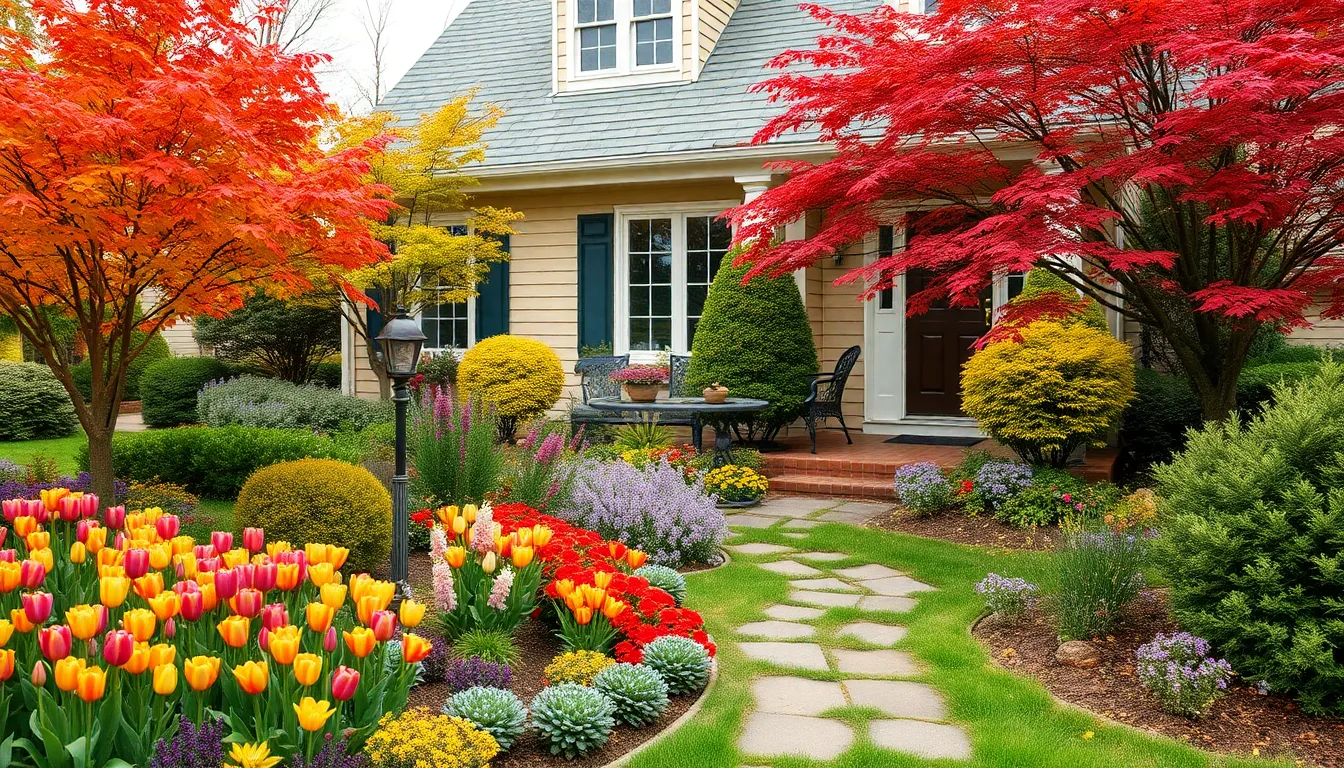
Maintaining visual appeal throughout all four seasons requires strategic planning that layers different plants and features for continuous color and texture. We’ll focus on creating a ever-changing front yard garden that evolves beautifully from spring through winter.
Plan for Spring Bulb Displays
Plant bulbs in fall for spectacular spring flowering displays that welcome the new growing season. Tulips, hyacinths, and narcissus should be planted in autumn when soil temperatures drop consistently below 60°F for optimal root development.
Layer bulbs at various depths to extend your bloom period and create waves of color. Deep bulbs like tulips (6-8 inches) bloom later than shallow crocuses (3-4 inches), giving you weeks of continuous flowers rather than a brief burst.
Group bulbs together in clusters of 15-25 for maximum visual impact near your front entrance or foundation beds. Single scattered bulbs get lost in the industry, but concentrated groupings create stunning focal points that draw the eye and enhance curb appeal.
Choose Plants With Fall Color
Ornamental trees deliver the most dramatic autumn transformation in your front yard garden. Japanese maples and sugar maples provide spectacular red, orange, and yellow foliage that can be seen from the street and significantly boost your home’s seasonal appeal.
Shrubs like redtwig dogwood and burning bush (Euonymus alatus) offer vibrant red stems and leaves that create striking contrast against evergreen backdrops. These hardy selections maintain their color intensity even through early frost periods.
Perennials such as sedum and asters provide late season color when most other flowers have faded. These reliable performers bloom from September through October, bridging the gap between summer flowers and winter dormancy while attracting beneficial pollinators.
Include Winter Interest Elements
Berries from winterberry and hawthorn display bright red colors throughout the coldest months, creating natural ornaments against snow and gray winter skies. These native selections also provide essential food sources for overwintering birds.
Evergreens like conifers and hollies maintain their green structure when deciduous plants go dormant, ensuring your front yard doesn’t look barren during winter months. Boxwoods and broadleaf evergreen shrubs offer year round foundation while requiring minimal maintenance.
Bark and seed heads add textural elements that shine in winter landscapes. Trees with peeling or colorful bark such as paperbark maple provide visual interest, while ornamental grasses and perennial seed heads create movement and architectural form that looks beautiful even covered with frost or light snow.
Establish a Cottage Garden Style Front Yard
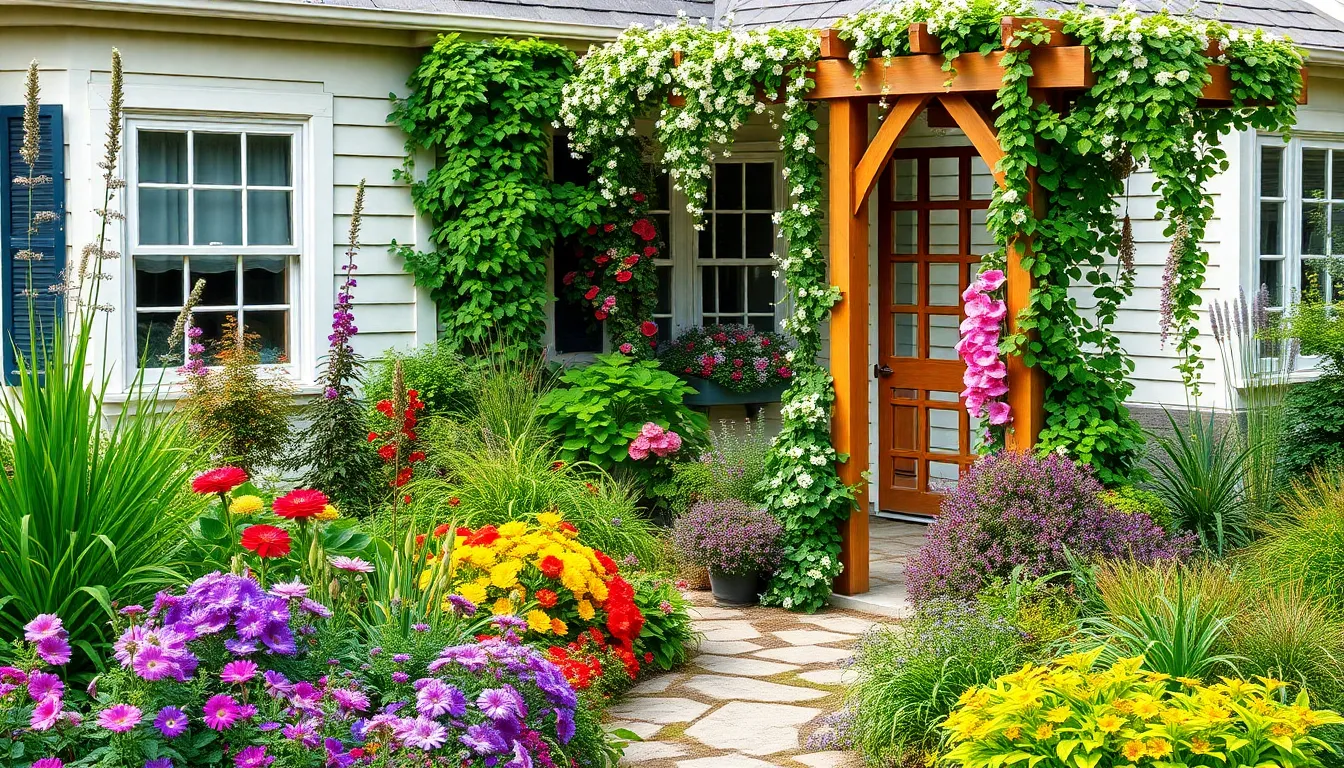
Creating a cottage garden style transforms your front yard into a charming, welcoming space that feels naturally abundant. This approach combines informal beauty with practical elements that guide visitors through your industry.
Mix Flowers and Foliage Plants
Layered plantings create the foundation of cottage garden appeal. We recommend combining flowering perennials with textured foliage plants to establish depth throughout your garden beds. Flowering plants like delphiniums and hollyhocks provide vertical interest while leafy hostas and ornamental grasses add contrasting textures at ground level.
Strategic flower selection ensures continuous color from spring through fall. Choose varieties that bloom at different times such as early spring crocuses, summer roses, and late-season asters. This succession planting technique guarantees your cottage garden maintains visual interest when other front yards lose their appeal.
Foliage plants serve as the backbone between blooming periods. Silver-leafed artemisia and purple-toned heuchera provide consistent color while lamb’s ear adds soft texture that complements delicate flower petals. These plants fill gaps between flowering seasons and create cohesive visual flow throughout your design.
Use Informal Planting Patterns
Unstructured layouts define authentic cottage garden character. We suggest avoiding rigid geometric patterns in favor of gentle curves and natural clusters that mimic how plants grow in nature. This approach creates a relaxed atmosphere that invites exploration rather than formal observation.
Texture combinations enhance visual appeal through strategic plant placement. Mix fine-textured grasses with broad-leafed perennials and spiky architectural plants like yucca or agapanthus. This variety prevents monotony while maintaining the casual, unplanned appearance that makes cottage gardens so appealing.
Natural groupings replace formal spacing requirements. Plant in odd-numbered clusters of three or five rather than single specimens or straight rows. Allow plants to spill over pathway edges and intermingle at borders to achieve that coveted “organized chaos” look.
Include Climbing Vines on Structures
Trellises and arbors provide essential vertical elements for cottage garden design. We recommend installing these structures near entryways or along pathways where climbing vines can create natural frames and add overhead interest. Wooden or wrought iron materials complement the informal cottage aesthetic better than modern metal alternatives.
Vine selection determines both seasonal interest and maintenance requirements. Clematis offers spectacular blooms in purple, pink, or white while climbing roses provide classic cottage garden romance with their fragrant flowers. Both varieties deliver foliage coverage during growing seasons and interesting architectural elements during winter months.
Strategic placement maximizes climbing vine impact throughout your front yard. Position structures where they’ll receive adequate sunlight for blooming while creating natural divisions between different garden areas. We suggest placing arbors at garden entrances and trellises against walls or fences to maximize growing space without overwhelming smaller front yard areas.
Plan for Easy Maintenance and Care

Creating a front yard garden doesn’t have to mean endless hours of upkeep. Smart planning and strategic choices can transform your space into a beautiful industry that practically maintains itself.
Choose Plants Suited to Your Climate Zone
Climate considerations form the foundation of any successful low maintenance garden. We recommend selecting plants that naturally thrive in your local temperature and precipitation conditions rather than fighting against nature’s patterns. Plants adapted to your exact zone require less water, fertilizer, and protection from weather extremes.
Seasonal interest becomes effortless when we choose varieties offering multi-seasonal attributes like colorful foliage, flowers, berries, and distinctive bark. Native gardens and xeriscapes prove especially manageable compared to traditional lawns or vegetable plots since they’ve evolved to flourish in local conditions without constant intervention.
Waterwise shrubs like lavender and barberry provide structure while requiring minimal irrigation once established. Ornamental grasses such as fountain grass and feather reed grass add movement and texture while thriving in various conditions. Succulents offer sculptural beauty in dry climates, while hardy perennials return year after year without replanting.
Design Wide Pathways for Garden Access
Accessibility ensures we can easily reach all garden areas for routine maintenance without damaging plants or compacting soil. Wide pathways allow comfortable movement with tools, wheelbarrows, and garden supplies while creating an inviting flow through the industry.
Eco-friendly materials like permeable pavers and gravel offer sustainable pathway answers that allow water penetration and reduce runoff. These materials require less maintenance than traditional concrete while supporting healthy soil drainage around plant roots.
Strategic placement of pathways reduces foot traffic through planted areas and provides clear access routes to irrigation controls, compost areas, and tool storage. Mulched garden beds alongside pathways suppress weeds naturally and retain soil moisture, minimizing our watering and weeding responsibilities.
Install Efficient Irrigation Systems
Water conservation through drip irrigation and rain sensor systems minimizes waste while delivering optimal moisture directly to plant roots. These efficient systems reduce our manual watering time while ensuring plants receive consistent moisture levels.
Automation via timers and smart irrigation controllers eliminates guesswork and scheduling conflicts in our garden care routine. Modern systems adjust watering schedules based on weather conditions and soil moisture levels, preventing both drought stress and overwatering damage.
Targeted delivery through efficient irrigation means healthier plants with stronger root systems that naturally resist pests and diseases. Mulching around irrigation emitters further reduces evaporation and weed growth, creating a self-sustaining cycle that requires minimal intervention from us.
Conclusion
Creating your dream front yard garden doesn’t have to be overwhelming when you break it down into manageable steps. We’ve explored many approaches that cater to different lifestyles budgets and maintenance preferences.
The key to success lies in choosing elements that work harmoniously together while reflecting your personal style. Whether you’re drawn to sustainable xeriscaping cottage garden charm or modern minimalism the right combination of plants hardscaping and design principles will transform your outdoor space.
Remember that the best front yard gardens evolve over time. Start with a solid foundation of structural elements and gradually add layers of interest as your confidence and experience grow. Your front yard is an investment in both your home’s value and your daily enjoyment of the space.
Frequently Asked Questions
What are the best plants for foundation plantings in front yards?
Evergreen shrubs like boxwood, yew, and holly are excellent choices for foundation plantings as they provide year-round structure and color. These low-maintenance plants create a bridge between your home’s architecture and surrounding landscape. Consider adding flowering perennials that bloom at different times for seasonal interest, and plant them in clusters for maximum visual impact.
How can I create curved garden beds in my front yard?
Design curved garden beds that complement your home’s architecture using natural stone or brick edging to define the spaces and prevent soil migration. Plant in layers from tall to short plants to maximize visual impact and ensure all plants receive adequate sunlight. This layered approach creates depth and visual interest in your front yard design.
Can I grow vegetables in my front yard garden?
Yes, front yard vegetable gardens combine functionality with curb appeal. Choose attractive edible plants like colorful bell peppers, Swiss chard, and purple kale for visual appeal. Use raised beds for better organization and drainage, install drip irrigation for water efficiency, and place herbs like basil, rosemary, and thyme near kitchen windows for easy access.
What trees work best for adding vertical interest to small front yards?
For narrow spaces, choose columnar trees like apple trees and ‘Sky Pencil’ holly that provide impressive vertical impact without taking up much ground space. Shade trees like oak and maple offer long-term value and seasonal color changes. Evergreen screens such as cedar and arborvitae create privacy while maintaining aesthetic appeal through strategic placement.
How do I create a low-water front yard garden?
Select drought-tolerant plants like shrub roses and pink alstroemeria that thrive with minimal irrigation. Use organic mulch to retain soil moisture and prevent weeds. Group plants by water requirements using hydrozoning techniques, creating distinct areas for high, medium, and low-water plants to maximize irrigation efficiency and conserve water.
What hardscape elements should I include in my front yard?
Build pathways using natural materials like stone pavers, gravel, or wooden planks for enhanced functionality and aesthetics. Add decorative garden borders with edging stones, brick, or living plants to define spaces. Install low retaining walls for slopes to create tiered planting areas and built-in seating opportunities while stabilizing the landscape.
How can I attract pollinators to my front yard garden?
Use native flowering plants like coneflowers and bee balm that attract regional pollinators and require minimal maintenance. Plan color combinations to attract different pollinators and include plants that bloom throughout seasons for continuous nectar sources. Add water features like shallow birdbaths and small ponds to attract diverse wildlife and create pollinator rest stops.
What plants provide year-round interest in front yards?
Plan spring bulb displays by planting bulbs in fall for vibrant spring blooms. Select ornamental trees and shrubs that provide fall color, and incorporate evergreens with colorful berries for winter interest. Layer different plants and features to create a front yard that evolves beautifully through all four seasons.
How do I create a cottage garden style front yard?
Mix flowering perennials with textured foliage plants to establish depth and continuous seasonal color. Use informal planting patterns with gentle curves and natural clusters to enhance the relaxed cottage garden atmosphere. Incorporate climbing vines on trellises and arbors for vertical interest and seasonal appeal, choosing varieties known for beauty and fragrance.
What are the keys to low-maintenance front yard gardening?
Select plants suited to your local climate to minimize upkeep, choosing waterwise shrubs and ornamental grasses for their low maintenance needs. Design wide pathways for easy access and use eco-friendly materials for sustainability. Install efficient irrigation systems like drip irrigation with rain sensors to conserve water and reduce manual watering time.

